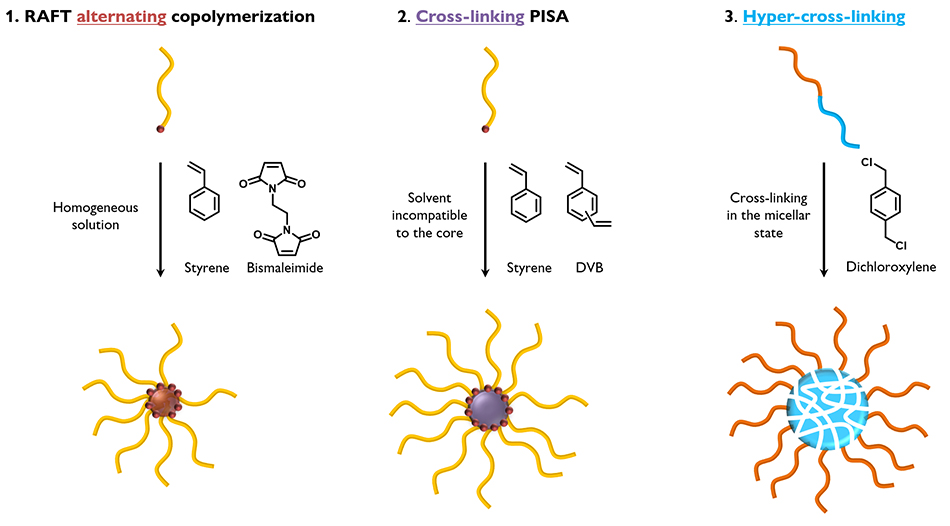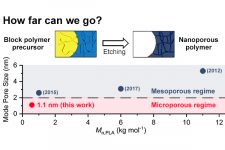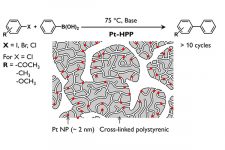Alternating copolymerization Battery Block polymer Bottlebrush polymer CCS polymer Composite Copolymer Cross-linking Emulsion Graft copolymer Hierarchical pore structure Hyper-cross-linking Interface Ionic liquid Macroporous Membrane Mesoporous Metal nanoparticle Micelles Microfluidics Microphase separation Microporous Mixed-matrix membrane MOF Noncovalent interaction Permselectivity Phase separation Phase transition Photopolymerization PIMS PISA Poly(arylene ether) Polycondensation Polymer particle Porous polymer Postpolymerization modification RAFT polymerization ROP Self-assembly Sequence control SNAr reaction Sulfonation Supramolecular chirality Surface modification Thiol-ene reaction
Core cross-linked star (CCS) polymer consists of multiple arms tethered on the densely cross-linked core. The discrete core-shell structure of this spherical and hairy nanoobject is constructed via covalent bonds. We are exploring synthesis, compartmentalization, and functionalization of CCS polymers towards Janus functional nanoobjects useful for interfacial and catalytic applications.
A CCS polymer may be compared to a spherical micelle formed by self-assembly of diblock copolymers in a selective solvent. Both possess spherical cores with diameters of tens to several tens of nanometers, and linear chains radiating from the core allow the nanoobjects to be dispersed in solution. The cross-linked core, however, stabilizes the CCS polymer even in a good solvent to retain the morphology. There is no critical micellar concentration in the CCS polymer, as the covalently bonded structure persists upon dilution while the diblock copolymer micelles will be dissociated into unimers. Thus the discrete core can be used as a stable nanocompartment for loading molecular cargoes. Furthermore, the CCS polymer can behave as hairy Janus nanoparticles if two different polymer chains can be tied to the core and segregated within the shell. Such heteroarm or miktoarm CCS polymers are anticipated to be useful as interfacial agent as the intramolecularly segregated architecture is theoretically predicted to stabilize an interface to great extent. However, a rational approach to controlling spatial arrangements of the constituting arms has been missing.
Developing new routes to CCS polymer synthesis

CCS polymers can be prepared by chain extension with cross-linkers. In this so-called arm-first route, for instance, atom transfer radical polymerization of divinylbenzene (DVB) in the presence of macroinitiators bearing halogen atoms at the chain end produces a CCS polymer. However, this has been tricky for reversible addition-fragmentation chain transfer (RAFT) polymerization which relies on degenerative chain transfer process between propagating radical species. The propagating linear chain species does not want to join the sterically hindered core, resulting in broad molar mass distribution in the CCS polymer.
We have shown that RAFT alternating copolymerization of styrene with bismalemide in the presence of a macro-chain transfer agent (macro-CTA) can effectively produce well-defined CCS polymer.1,2 In contrast to DVB, the chains are forced to find dangling maleimide bonds on the core to propagate in an alternating manner. A CCS polymer with molar mass of several hundred kg mol-1 can be obtained with dispersity lower than 1.2.
Polymerization-induced self-assembly (PISA) can be also utilized to confine cross-linking polymerization in the core.3 By choosing a selective solvent that can readily dissolve the macro-CTA and the cross-linker but not the forming polymer, the growing core is segregated from the polymerization mixture. We found that by tuning the monomer/cross-linker ratio, shape of the resulting CCS polymer can be affected. A branched core can be produced by DVB copolymerization, while high cross-linking density established in the early stage by bismaleimide yields leads to a rather spherical core.
In the selective solvent, block polymer micelles can be transformed into a CCS polymer by external cross-linking reaction. Hyper-cross-linking can be one example that knits aromatic rings with methylene linkages via Friedel-Crafts alkylation catalyzed by a Lewis acid. As PMMA is intact in the reaction condition, a core hyper-cross-linked polymer can be obtained from PMMA-b-PS micellar precursor.4 The spacious core generated by hyper-cross-linking can uptake hydrophobic guests, suggesting potential as nanocontainers.
Intramolecular segregation in miktoarm CCS polymers
As the arms are covalently tied to the core, they have significantly restricted configurational freedom. In order to induce intramolecular segregation, the spatial arrangement of different polymer arms should be appropriately made when they are connected to the core. One of the possibilities we are focusing on is to employ polymerization-induced intramolecular segregation. While PISA in a selective solvent produces aggregation of block polymer chains, growing the second chain from the core that is immiscible with the first arm or solvent can segregation within the CCS morphology. A narrow interface builds up between the two different arms, resulting in the miktoarm CCS polymer as a Janus-like polymer nanoobject.

The miktoarm CCS polymer can aggregate further to form supermicelles in a selective solvent. As the degree of intramolecular segregation increases, supermicelles with narrow size distribution can be obtained. A transmission electron micrograph shows highly uniform assemblies of the miktoarm CCS polymers, supporting their intramolecularly segregated nature.

1. “Heteroarm core cross-linked star polymers via RAFT copolymerization of styrene and bismaleimide”, Nam Young Ahn and Myungeun Seo*, RSC Adv. 6, 47715-47722 (2016).
2. “Synthetic route-dependent intramolecular segregation in heteroarm core cross-linked star polymers as Janus-like nanoobjects”, Nam Young Ahn and Myungeun Seo*, Polym. Chem. 11, 449-460 (2020) (Invited Paper to a Special Issue “Emerging Investigators 2020”).
3. “Cross-linking polymerization-induced self-assembly to branched core cross-linked star block polymer micelles”, Jongmin Park, Nam Young Ahn and Myungeun Seo*, Polym. Chem. 11, 4335-4343 (2020).
4. “Core hyper-cross-linked star polymers from block polymer micelle precursors”, Jongmin Park, Stefan J. D. Smith, Colin D. Wood, Xavier Mulet and Myungeun Seo*, Polym. Chem. 11, 7178-7184 (2020) (Invited Paper to a Special Issue “Pioneering Investigators 2021”).

